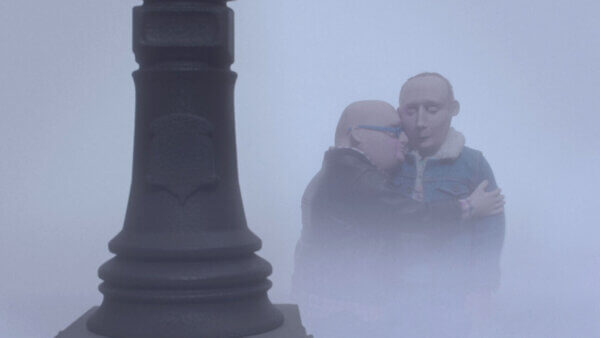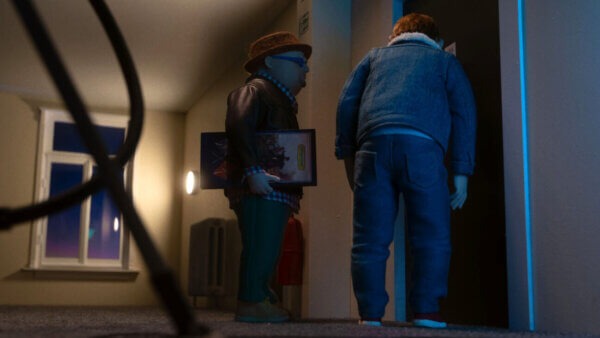Beautiful Men | Interview with Nicolas Keppens
Among this year’s crop of Oscar nominated animated shorts lies Beautiful Men, a quiet, stop-motion tale of three brothers who head to Istanbul looking for hair transplants. The film is an exploration of beauty standards for men in a way that extends beyond just male pattern baldness. These characters are trying to feel comfortable in their skin, looking at fitness magazines and sports stars with envy; looking at their own bodies with fear and disgust.
Beautiful Men’s director, Nicolas Keppens, pivoted last minute from his usual medium of 2D animation to stop-motion, hammering home the tactility and realism of the issues he’s exploring. Skwigly caught up with Keppens the day before he flew out to LA on his Oscars odyssey.
When did the idea first come to you, and why did you feel it was important to tell this story?
In 2018 or ’19 I went to Istanbul for work, and was staying in a hotel my colleague had booked without knowing it had a collaboration with a hair clinic. So in the morning, we entered the breakfast room and it was packed with almost only balding man sitting alone, just being rather quiet. If you imagine a breakfast room with only men being on holiday, you’d think about guys having a hangover or just being boys, but there was nothing like that. It was a super tender sight for me, so I thought it was a good starting point.
What were your biggest influences?
I’m a big fan of the visuals of Federico Fellini, and when I started working on the script, I discovered my love for his films. I discovered I Vitelloni which is about men being together and just hanging out. It’s set in a small town, and in the end of the film, which is a directly referenced for the ending of Beautiful Men, the last guy is leaving the town where everything is set, and while he is watching through the window of the train he sees the villagers sleeping, not caring about him or what happened. They have this adventure and they think they are the whole world and then when they leave, no one really cares.
I thought that was a very beautiful idea, which also reminded me of a painting by Pieter Bruegel called Landscape with the Fall of Icarus. The beautiful thing about this painting is that you see an important thing in history, the fall of Icarus into the sea, which is a big drama for one person and his father, but the whole world goes on. There is a farmer in the foreground, just carrying on. These were two big references for the ending and why I chose to make him look out of the car window and see the sets of the film with the puppets not caring, or even not being moved, in a very physical way.
Through the three main characters you explore a different side of beauty standards and health issues for men. Was that a complicated thing to figure out?
I make it easy for myself by not having too much backstory for my characters. When I wrote too much of a backstory, I started to over think reasons why they’d do something, and I think people aren’t that consistent. For me, it helps to just base them on people around me and being honest with myself that I’m not consistent either, which then helps me to have more themes in one person.
A lot of your work before this has been in 2D animation. What made you want to go stop motion for this one?
Beautiful Men was a 2D animation until very late in the process when I rewrote the final draft, and suddenly it became much more about loneliness and the tactility of the skin. It’s not at all impossible to draw a character expressing loneliness but it was much harder than just having a puppet sitting on an empty bed in a room and the idea that it’s a puppet is so touching. I bought a book with the script and some making-of pictures of Anomalisa and there were some images of the puppets with the rigs, not hiding at all that these were puppets. It was so heartbreaking to see them just waiting to be moved. I wanted to use that feeling.
Did it also help contribute to the realism of the film?
Yeah, the thing with stop-motion, is it’s this wonderful technique where you have the balance between the magic of animation and of early cinema. The fact that it shows realism so easily, it’s this balance that interests me a lot.
What was the biggest challenge when designing the puppets?
I didn’t want to get too realistic. They’re almost uncanny, but it’s not quite uncanny. I’ve also never done stop-motion before, so I was learning about what was possible with the puppets, and in the end, we had puppets that were really hard to animate because there’s a lot of silicon in them. This made them heavy and sturdy,because the characters are not thin like Jack Skellington or whatever. Also the heads are not separated from the body. Because the film talks about baldness, I really wanted the head to connect with the back without any lines. That was annoying for the animators, but it also meant that they only could do subtle movements which ended up as a good thing in the film.
How does it feel to be nominated for an Oscar?
It’s overwhelming already. I really like being in my workshop and drawing and just doing my thing and the beautiful thing about being an animation director is that you can get rather famous without being recognized. But then there are the Oscars and it’s out of my comfort zone, but I’m really happy, of course, and I’m going to LA with the opportunity of meeting people that contact you because of the nomination so doors are a bit more open.
The 97th Academy Awards take place on March 2nd 2025 at 7pm ET/4pm ET (March 3rd at 12 am GMT)




